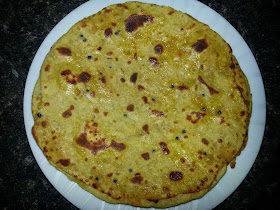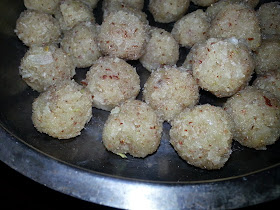Ganapathi Homam is generally performed before starting any new venture or businesses, getting into a new job, before getting into a new home, etc., Its always good to perform Ganapathy Homam once a year to get happiness, prosperity, health and wealth and be victorious in all the deeds we perform. This homam can also be performed to please Kethu so if any person has Kethu Dasa, he could participate in this Homam. In Southern part of India, people starts all rituals first by performing the Ganapathy Homam.
Mostly people do a special kind of Modak ( Kozhukattai ), appam and offer to Lord Ganesha. In addition to these prasadams, the priest prepares a very special prasadam using nuts, dry grapes, honey, aval ( Poha thin flakes ), kalkandu , chopped dates, little rose water. In that, small pieces of fried modaks and appam will also be added which in turn make the prasadam so tasty. I love this prasadam very much and used to store it for a week atleast and enjoy by myself. Also its a very healthy treat.!!!

Preparing fried Kozhukkati / Modak in specified numbers ( like 16, 21, 51 or 108 as mentioned by the priest ) is a must during Ganapathy Homam. Making the inside poornam is the same as the one we make for the regular white Kozhukattai. For the outer cover, I used whole wheat flour, little all purpose flour and rava ( sooji ). You can either fry the modaks in pure ghee or in regular cooking oil. In temples, they fry the modaks in pure ghee only. So, the modaks which come from the Ganapathy Agraharam temple will always taste the best.!!!
Ingredients ( For Making 28 Kozhukattai )
Outer Cover
Whole Wheat Flour - 2 Cups
All Purpose Flour - 1/2 cup
Rava - 1 Handful
Salt - As Required ( Should be less )
Water - As required to make a thick dough for the outer cover.
Poornam
Fresh Shredded Coconut - 2 Cups
Jaggery - 1.5 Cup
Cardamom Powder - 2 tsp
Ghee - 1 tbsp
Oil for frying the Modaks. ( In that, I added few tsps of Ghee just for flavour ).
Method
Make a thick dough using the above ingredients using little water. Consistency of the dough is very important otherwise the outer cover might crack while frying.
Make the poornam in a thick pan by mixing all the ingredients as mentioned above. Keep the poornam in the stove till you get a consistency enough to make small balls for the Modak.
After its cooled down a bit, make small balls and keep ready.
Take a portion of the outer cover dough and spread them using a Chappathi roller. It should be thicker than the regular chappathi. Using a small lid or coffee filter lid, make small rounds as shown below.
Put the poornam inside the rounds and close the Modak carefully. Make sure that the poornam is safely covered in all directions so that it does not ooze out while frying. Continue this process and keep the Modagams ready for frying.
Then fry the Modaks slowly in the boiling oil on medium heat only. If you fry them on high heat, the modaks might get fried faster and turn darker. So, fry them carefully on low or medium heat and yield golden coloured ones.
Vakratunda Mahakaaya
Suryakoti Samaprabha
Nirvighnam Kuru Mey Deva
Sarva Kaaryeshu Sarvada







